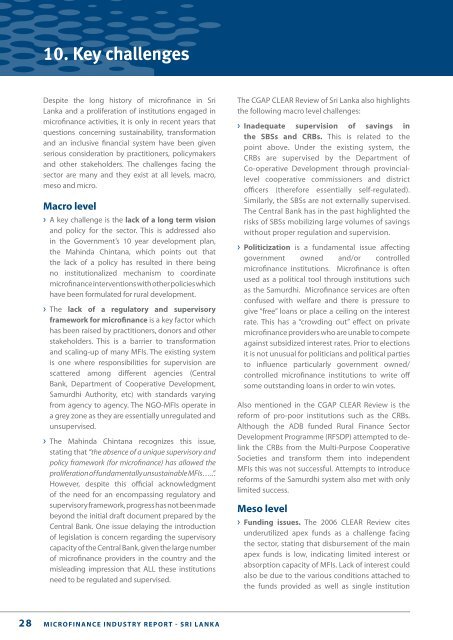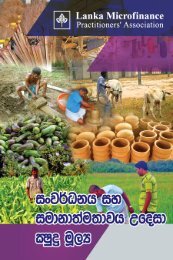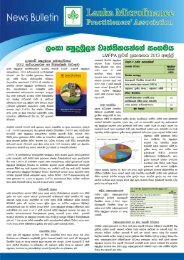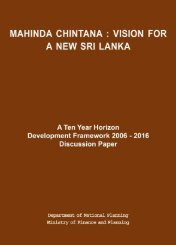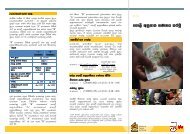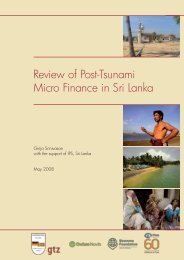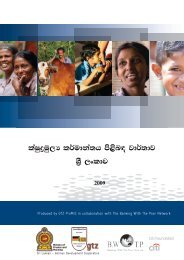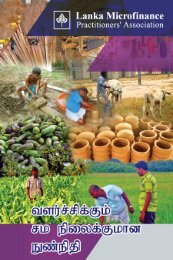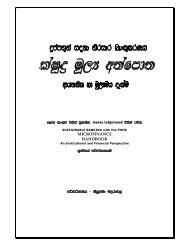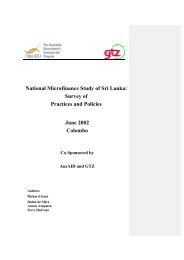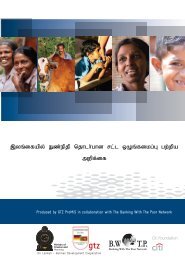Microfinance Industry Report SRI LANKA - Microfinance in Sri Lanka
Microfinance Industry Report SRI LANKA - Microfinance in Sri Lanka
Microfinance Industry Report SRI LANKA - Microfinance in Sri Lanka
You also want an ePaper? Increase the reach of your titles
YUMPU automatically turns print PDFs into web optimized ePapers that Google loves.
10. Key challenges<br />
Despite the long history of microf<strong>in</strong>ance <strong>in</strong> <strong>Sri</strong><br />
<strong>Lanka</strong> and a proliferation of <strong>in</strong>stitutions engaged <strong>in</strong><br />
microf<strong>in</strong>ance activities, it is only <strong>in</strong> recent years that<br />
questions concern<strong>in</strong>g susta<strong>in</strong>ability, transformation<br />
and an <strong>in</strong>clusive f<strong>in</strong>ancial system have been given<br />
serious consideration by practitioners, policymakers<br />
and other stakeholders. The challenges fac<strong>in</strong>g the<br />
sector are many and they exist at all levels, macro,<br />
meso and micro.<br />
Macro level<br />
> > A key challenge is the lack of a long term vision<br />
and policy for the sector. This is addressed also<br />
<strong>in</strong> the Government’s 10 year development plan,<br />
the Mah<strong>in</strong>da Ch<strong>in</strong>tana, which po<strong>in</strong>ts out that<br />
the lack of a policy has resulted <strong>in</strong> there be<strong>in</strong>g<br />
no <strong>in</strong>stitutionalized mechanism to coord<strong>in</strong>ate<br />
microf<strong>in</strong>ance <strong>in</strong>terventions with other policies which<br />
have been formulated for rural development.<br />
> > The lack of a regulatory and supervisory<br />
framework for microf<strong>in</strong>ance is a key factor which<br />
has been raised by practitioners, donors and other<br />
stakeholders. This is a barrier to transformation<br />
and scal<strong>in</strong>g-up of many MFIs. The exist<strong>in</strong>g system<br />
is one where responsibilities for supervision are<br />
scattered among different agencies (Central<br />
Bank, Department of Cooperative Development,<br />
Samurdhi Authority, etc) with standards vary<strong>in</strong>g<br />
from agency to agency. The NGO-MFIs operate <strong>in</strong><br />
a grey zone as they are essentially unregulated and<br />
unsupervised.<br />
>> The Mah<strong>in</strong>da Ch<strong>in</strong>tana recognizes this issue,<br />
stat<strong>in</strong>g that “the absence of a unique supervisory and<br />
policy framework (for microf<strong>in</strong>ance) has allowed the<br />
proliferation of fundamentally unsusta<strong>in</strong>able MFIs…..”.<br />
However, despite this official acknowledgment<br />
of the need for an encompass<strong>in</strong>g regulatory and<br />
supervisory framework, progress has not been made<br />
beyond the <strong>in</strong>itial draft document prepared by the<br />
Central Bank. One issue delay<strong>in</strong>g the <strong>in</strong>troduction<br />
of legislation is concern regard<strong>in</strong>g the supervisory<br />
capacity of the Central Bank, given the large number<br />
of microf<strong>in</strong>ance providers <strong>in</strong> the country and the<br />
mislead<strong>in</strong>g impression that ALL these <strong>in</strong>stitutions<br />
need to be regulated and supervised.<br />
The CGAP CLEAR Review of <strong>Sri</strong> <strong>Lanka</strong> also highlights<br />
the follow<strong>in</strong>g macro level challenges:<br />
>> Inadequate supervision of sav<strong>in</strong>gs <strong>in</strong><br />
the SBSs and CRBs. This is related to the<br />
po<strong>in</strong>t above. Under the exist<strong>in</strong>g system, the<br />
CRBs are supervised by the Department of<br />
Co-operative Development through prov<strong>in</strong>ciallevel<br />
cooperative commissioners and district<br />
officers (therefore essentially self-regulated).<br />
Similarly, the SBSs are not externally supervised.<br />
The Central Bank has <strong>in</strong> the past highlighted the<br />
risks of SBSs mobiliz<strong>in</strong>g large volumes of sav<strong>in</strong>gs<br />
without proper regulation and supervision.<br />
> > Politicization is a fundamental issue affect<strong>in</strong>g<br />
government owned and/or controlled<br />
microf<strong>in</strong>ance <strong>in</strong>stitutions. <strong>Microf<strong>in</strong>ance</strong> is often<br />
used as a political tool through <strong>in</strong>stitutions such<br />
as the Samurdhi. <strong>Microf<strong>in</strong>ance</strong> services are often<br />
confused with welfare and there is pressure to<br />
give “free” loans or place a ceil<strong>in</strong>g on the <strong>in</strong>terest<br />
rate. This has a “crowd<strong>in</strong>g out” effect on private<br />
microf<strong>in</strong>ance providers who are unable to compete<br />
aga<strong>in</strong>st subsidized <strong>in</strong>terest rates. Prior to elections<br />
it is not unusual for politicians and political parties<br />
to <strong>in</strong>fluence particularly government owned/<br />
controlled microf<strong>in</strong>ance <strong>in</strong>stitutions to write off<br />
some outstand<strong>in</strong>g loans <strong>in</strong> order to w<strong>in</strong> votes.<br />
Also mentioned <strong>in</strong> the CGAP CLEAR Review is the<br />
reform of pro-poor <strong>in</strong>stitutions such as the CRBs.<br />
Although the ADB funded Rural F<strong>in</strong>ance Sector<br />
Development Programme (RFSDP) attempted to del<strong>in</strong>k<br />
the CRBs from the Multi-Purpose Cooperative<br />
Societies and transform them <strong>in</strong>to <strong>in</strong>dependent<br />
MFIs this was not successful. Attempts to <strong>in</strong>troduce<br />
reforms of the Samurdhi system also met with only<br />
limited success.<br />
Meso level<br />
> > Fund<strong>in</strong>g issues. The 2006 CLEAR Review cites<br />
underutilized apex funds as a challenge fac<strong>in</strong>g<br />
the sector, stat<strong>in</strong>g that disbursement of the ma<strong>in</strong><br />
apex funds is low, <strong>in</strong>dicat<strong>in</strong>g limited <strong>in</strong>terest or<br />
absorption capacity of MFIs. Lack of <strong>in</strong>terest could<br />
also be due to the various conditions attached to<br />
the funds provided as well as s<strong>in</strong>gle <strong>in</strong>stitution<br />
28 microf<strong>in</strong>ance <strong>in</strong>dustry report - <strong>SRI</strong> <strong>LANKA</strong>


